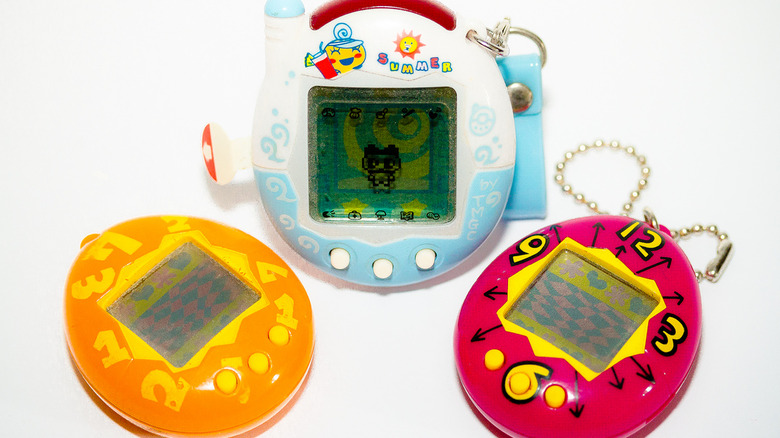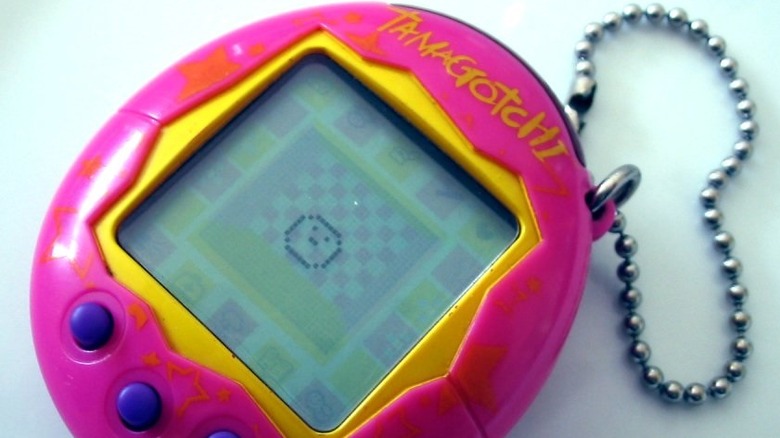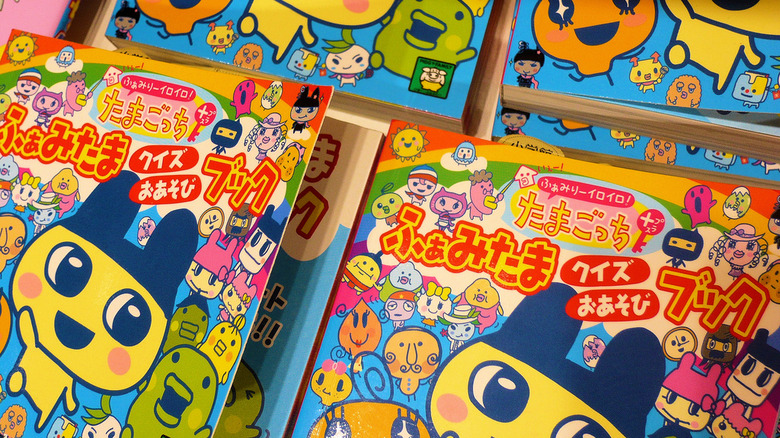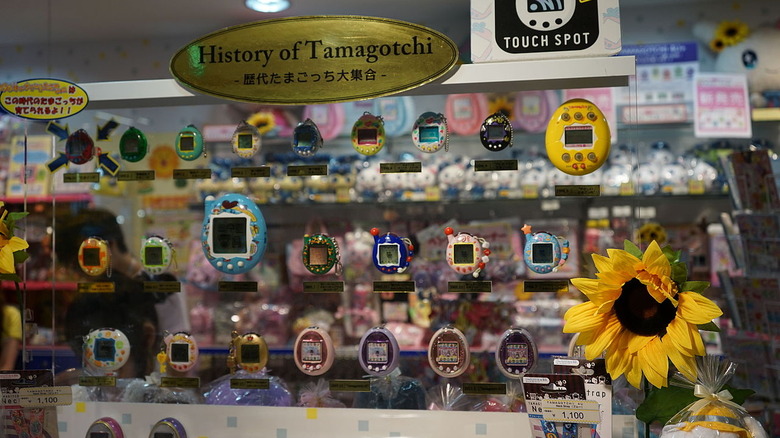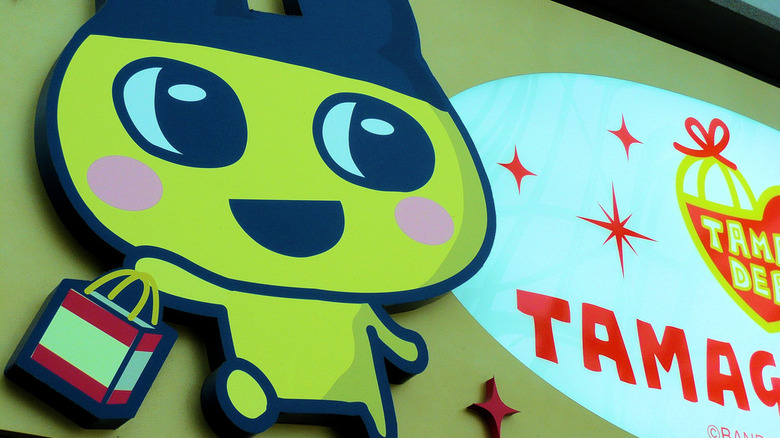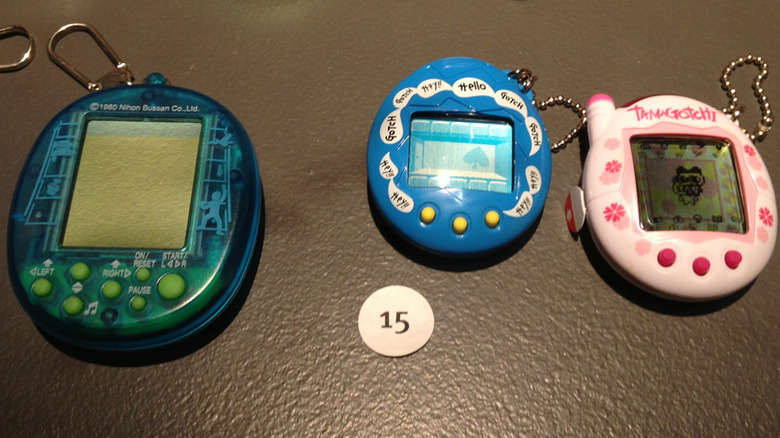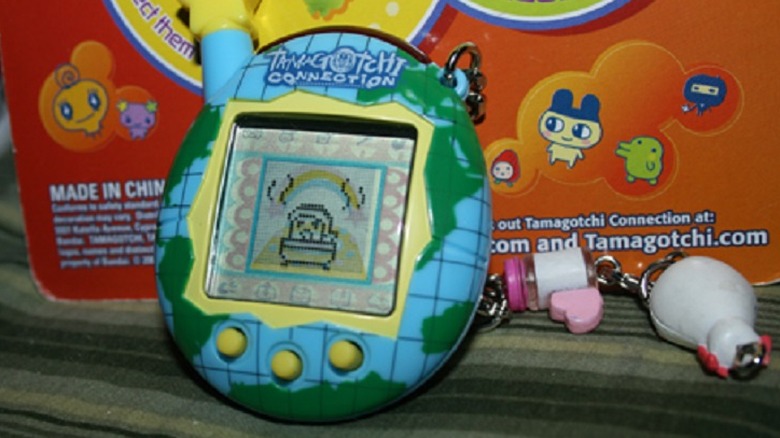The Untold Truth Of Tamagotchis
Tamagotchis were impossible to ignore when they were first released in the mid-1990s. Literally impossible, as they beeped incessantly, warning their owners when they were hungry, when they wanted to play, or when they had pooped all over their room. They were also impossible to ignore because of their massive popularity — kids were obsessed, and the egg-shaped phenomenon sold millions of units in just the first few years of release.
However, not everyone knows the full backstories of the little Tamagotchis. In fact, it can be difficult to even figure out what the word Tamagotchi means — some sources state that the name is a combination of the Japanese words tamago (egg) and tomodachi (friend), while others claim it is a combination of tamago and the English word "watch."
We're looking at some of those lesser known facts about Tamagotchi virtual pets. After all, there's a lot more to the little critters than beeping and pooping (even though that's what we remember the most).
Banned in schools and feared by psychologists
Popular entertainment trends always seem to draw fear and ire from older generations, from the devilry of rock and roll music, to the early controversies over video game violence, to school fights brought on by Fortnite. Tamagotchis were no exception. They were banned from several schools because their constant beeping was a distraction, and the short lifespans — especially those of the early generations, which could die in as little as half an hour if their needs weren't met — would keep students' attention away from their studies.
During their heyday, Tamagotchis caught the attention of psychologists as well as school officials. In an interview with the New York Times, one school psychologist feared that Tamagotchis were problematic to kids' mental health. "The toy creates a real sense of loss and a mourning process," explained Dr. Andrew Cohen. "Kids want to nurture and take care of pets — it gives them a feeling of empowerment and self-importance — but here the consequences are too high. It's out of control."
The same article said that the toys were often "cared for" by parents while their children were at school. Some psychologists argued that Tamagotchis could teach valuable lessons, but that more sensitive children could be severely hurt by the toy if their digital creature took a turn for the worst.
There were Tamagotchi anime and manga adaptations
When we think of Japanese cartoons featuring cute, collectible creatures, we tend to think of Pokémon. However, Tamagotchi had some animated adaptations as well, featuring a variety of different popular characters and several different iterations.
During the initial Tamagotchi craze, there was a Japan-only anime featuring the characters, but the most popular anime version of Tamagotchi in the west was called Let's Go! Tamagotchi, which later spawned a sister show just called Tamagotchi! These shows also spun off a few different animated movies: Tamagotchi: The Movie and Tamagotchi: Happiest Story in the Universe!
If you prefer your Tamagotchis static, there are also several manga adaptations based on the popular toy, including Found in the Manga! Tamagotchi and GoGo! Tamagotchi (which spawned a few variations). The comics take a few liberties with the backstory of fans' favorite digital creatures, but they feature the classic types of hijinks you would expect from a story about children and their odd pets.
Lest you think all Tamagotchi media is old news, the most recent Tamagotchi film was a short released in 2017. The film allowed fans to catch up with Mametchi, one of the most popular characters from Tamagotchi lore, on the 20th anniversary of the iconic toy.
Over 80 million Tamagotchis have sold worldwide
Chances are, if you were a kid in the mid-to-late '90s, you knew multiple people who owned these needy little buggers. They were a massive success both in their native Japan and abroad, and developer Bandai released some jaw-dropping sales figures when they celebrated the 20th anniversary edition of the toy in 2017.
Alongside the 20th anniversary release (which was an exact replica of the first generation toys originally released in 1996), Bandai announced that they had sold 82 million Tamagotchis as of September 2017. Even more shocking, 40 million Tamagotchis were sold in the first three years of release alone.
The press release suggests that Tamagotchis were enjoying a resurgence in several countries, including areas of Europe, Asia, and the United States. Bandai continued to highlight the strength of the Tamagotchi brand outside of Japan — 60 percent of those 82 million total units were actually sold across more than 50 different countries.
The unassuming creators
There are essentially two people credited with the creation of Tamagotchis: WiZ Toys designer Akihiro Yokoi and Aki Maita, who was a low-level clerical worker at Bandai. The story goes that Aki wanted a toy that would work with the small amount of space she had at home and also fit in with her busy work and social life. She also decided she had to come up with a "cute" toy that could break into the lucrative (but tough to crack) market of teenage girls.
She approached Akihiro with her idea, and the two worked together to design the toy. It was, as we know by now, a runaway success, but Aki apparently did not even receive a promotion for her multi-million dollar idea.
In fact, she hardly received any attention at all, outside of one strange award: the 1997 Ig Nobel Prize. This award is given out at Harvard University as a mockery of the true Nobel Prize, and "honors achievements that first make people laugh, and then make them think." She and Akihiro were given the 1997 award in Economics for "diverting millions of person-hours of work into the husbandry of virtual pets." Better than nothing.
There are some bizarre versions of the toy
If you ask most people what a Tamagotchi is, they will have a pretty good concept of a cute, weird little creature hopping around an egg-shaped home. And, for the most part, that'd be true — except for when you start diving into the weird world of special edition Tamagotchis. That's where you start finding some bizarre tie-in creations and just flat-out weird versions of the toy.
One such version is the Tamagotchi Angel, which features an already-dead Tamagotchi trying to make the most of its short time left on Earth before reaching its destination in the "afterlife," which is actually an interstellar journey. They function pretty much the same as regular Tamagotchis with a few variations — for one, they poop only when they finish praying ... just like we all do. They also feature a "bad ending" where the Tamagotchi Angel becomes a Devil!
Another very strange version of Tamagotchi is known as the Santaclautchi. Once the alien Tamagotchis return to their planet (which we'll talk about in a moment), they take the tradition of Christmas back with them. In this version of the toy, the player has to help a character on the Tamagotchi home planet become the true version of Santa Claus.
There are lots of different Tamagotchi versions, including licensed products based on Pokémon and Mothra. Plenty outside the ordinary.
Tamagotchis are aliens
Of course, Tamagotchis have an official story — and, of course, it's weird. Take a deep breath: here's the story behind your favorite virtual pets.
Newstalk writes that the original designers came up with the story to accompany their new hit toy. According to the lore, Tamagotchis were discovered by a hopeless romantic named Professor Banzo. He had just been dumped (for the 100th time!), and was wandering by the Sumida River, feeling sorry for himself. He heard a splash nearby, and he discovered a UFO full of alien creatures — Tamagotchis!
However, he also discovered that the creatures could not survive in Earth's atmosphere. Together with his assistant, they built egg-shaped casings to protect the creatures from the dangerous air surrounding them.
There are a few other fun facts the official instruction manual tells us about Tamagotchi biology. One human day is equal to about a year for a Tamagotchi. Their home planet is about a million light years from Earth, and when a Tamagotchi dies and turns into its angelic form, it is actually flying back to its home.
There's an official Tamagotchi cemetery in England (and an online memorial)
The Tamagotchi craze was a worldwide phenomenon, and of course there were plenty of savvy entrepreneurs ready to jump on board the hot new trend. One of the most innovative ways was in dealing with the death of the virtual pets – for people too devastated to start anew, why not create a burial place for the noisy little aliens?
In 1998, CNN reported on a pet cemetery in England that set aside a small area for Tamagotchis. They were given a coffin and a small bouquet to commemorate their lives, along with a short service. One devastated owner told CNN that she "wanted to remember her pet as it was and not as it would be if she had reset the gadget." Vice also writes about a Hungarian Tamagotchi resting place that supplied clay urns for the deceased virtual pets.
If you don't want to fly around the world to memorialize a Tamagotchi, there is also an official memorial on TamaTalk, which is one of the most popular Tamagotchi fan forums online. Owners are encouraged to post their favorite memories about their pets. This level of mourning for a toy may seem rife for mockery, but it's actually pretty touching.

